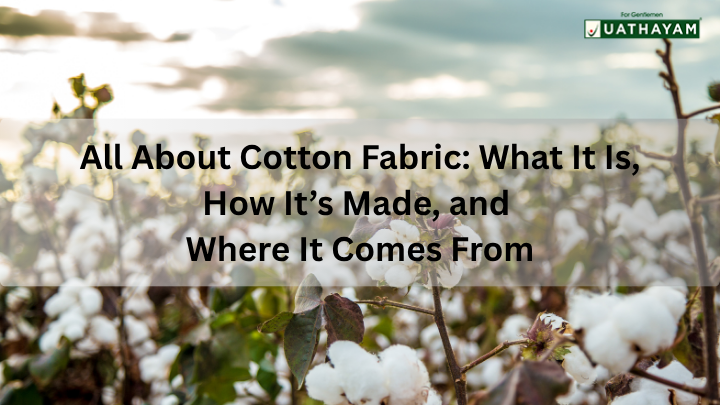Linen vs. Cotton: What's the Difference? What's Better In 2024?

The debate "linen vs cotton" is a longstanding one, with both fabrics offering unique benefits and drawbacks. As we are midway through 2024, the discussion remains relevant, especially for those looking to make informed decisions about their clothing, bedding, and other fabric needs.
This article will explore the differences between linen and cotton, evaluate their respective pros and cons, and help you determine which fabric might be the better choice for you this year.
What Is Linen Fabric?
Source: Linen is made from the fibres of the flax plant. The process of transforming flax into linen involves several steps, including retting, drying, and spinning, which are labour-intensive and time-consuming. This unique origin is a key aspect when comparing linen vs cotton.
Texture: Linen has a distinctive texture that is slightly rough initially but becomes softer with each wash. Its natural, slightly coarse feel is often considered part of its charm and appeal. When considering linen vs cotton, the initial roughness of linen contrasts with the immediate softness of cotton.
Appearance: Linen shirts are known for its natural, slightly wrinkled appearance. This look is often embraced for its casual, rustic aesthetic, which adds character to garments and home textiles. In the linen vs cotton debate, linen's inherent wrinkles give it a unique visual appeal.
Durability: Linen is one of the strongest natural fibres, known for its durability and longevity. With proper care, linen items can last for decades, making them a worthwhile investment. Comparing linen vs cotton, linen generally outlasts cotton due to its robust fibres.
Breathability: Linen is highly breathable, making it an excellent choice for hot and humid climates. It effectively wicks moisture away from the body, helping to keep you cool and dry. This breathability is a significant factor in the linen vs cotton comparison, especially for summer clothing.
Environmental Impact: Linen is an eco-friendly fabric. The flax plant requires fewer pesticides and fertilizers than cotton, and linen is biodegradable, reducing its ecological footprint. In the linen vs cotton context, linen often wins out as the more sustainable option.
What is Cotton Fabric?
Source: Cotton is derived from the fluffy bolls of the cotton plant. The process involves harvesting the cotton, cleaning it to remove seeds and impurities, and spinning the fibres into yarn. This straightforward cultivation is a key point in the linen vs cotton discussion.
Texture: Cotton is soft and smooth, offering a comfortable feel against the skin. Its softness makes it a popular choice for everyday clothing and bedding. When comparing linen vs cotton, the immediate softness of cotton is a major advantage.
Appearance: Cotton shirts can have a smooth and crisp appearance, making it versatile for a variety of uses, from casual wear to formal attire. In the linen vs cotton debate, cotton's smoothness offers a different aesthetic compared to linen's natural wrinkles.
Durability: Cotton is durable but generally less strong than linen. However, it can withstand frequent washing and use, making it a practical choice for many applications. In terms of linen vs cotton, while cotton is durable, it does not typically match the longevity of linen.
Breathability: Cotton is also breathable but tends to hold more moisture than linen. This characteristic can make cotton feel heavier and less comfortable in very hot, humid conditions. Comparing linen vs cotton, linen often provides better comfort in hot weather due to its superior moisture-wicking properties.
Environmental Impact: Cotton cultivation is resource-intensive, requiring significant water, pesticides, and fertilisers. Organic cotton is a more sustainable choice, though it still needs more resources than linen. In the linen vs cotton sustainability debate, linen generally has a lower environmental impact.
Comparing Linen and Cotton (linen vs cotton)
Now that we understand the basic characteristics of linen and cotton let's compare them in various aspects to see how they stack up against each other. The comparison of linen vs cotton can help you determine which fabric is more suitable for your specific needs.
Comfort and Feel
Linen:
- Initial Texture: Linen has a crisp, slightly rough texture when new, which can be surprising if you're used to softer fabrics. However, it softens beautifully over time with each wash, becoming more comfortable.
- Coolness: Linen feels cool to the touch, making it ideal for hot weather. Its natural breathability allows air to flow easily, keeping you cool and comfortable.
- Unique Feel: The unique, slightly textured feel of linen is often described as luxurious and sophisticated, adding an element of charm to garments and bedding.
Cotton:
- Immediate Softness: Cotton is soft and smooth right from the start, providing instant comfort. This makes it a popular choice for clothing and bedding that is in direct contact with the skin.
- Warmth: While cotton is breathable, it tends to retain more heat compared to linen. This can make it feel warmer, which might be more comfortable in cooler climates.
- Versatility: Cotton's soft texture is highly versatile and suitable for a wide range of applications, from casual wear to more formal attire.
Temperature Regulation
Linen:
- Breathability: Linen is renowned for its breathability. It allows air to circulate freely, which helps regulate body temperature and keep you cool in hot weather.
- Moisture-Wicking: Linen's ability to wick moisture away from the body ensures that sweat is quickly evaporated, reducing the clammy feeling often associated with humid conditions.
Cotton:
- Breathable but Moisture-Retentive: Cotton is also breathable but tends to hold onto moisture. This can make cotton feel damp and heavy in very hot, humid conditions.
- Temperature Regulation: Cotton can absorb a significant amount of moisture before feeling wet, which can be beneficial in moderate climates but less ideal in extreme heat.
Durability
Linen:
- Strong Fibres: Linen is one of the strongest natural fibres, known for its durability. It can withstand frequent use and washing without losing its integrity.
- Longevity: With proper care, linen items can last for decades. They often become softer and more comfortable over time, making them a good long-term investment.
Cotton:
- Durable but Less Strong: Cotton is durable but generally less strong than linen. Over time, especially with heavy use and frequent washing, cotton fibres can break down.
- Frequent Replacement: Cotton items, while sturdy, might need to be replaced more frequently compared to linen, particularly in high-use situations like bedding and towels.
Maintenance
Linen:
- Care Requirements: Linen requires a bit more care to maintain its quality. It's best washed in cool water and air-dried to prevent shrinking and maintain the integrity of the fibres.
- Wrinkling: Linen is prone to wrinkles, which can be part of its natural charm but may require ironing if a smoother look is desired.
Cotton:
- Easy Care: Cotton is low-maintenance and can be washed in hot water and tumble-dried, making it convenient for everyday use. It's more resistant to shrinking and can handle more aggressive washing techniques.
- Wrinkle Resistance: Cotton tends to be less prone to wrinkles compared to linen, although it can still wrinkle depending on the weave and quality.
Environmental Impact
Linen:
- Eco-Friendly Cultivation: Linen, derived from the flax plant, requires fewer pesticides and fertilisers than cotton. It also uses less water, making it a more sustainable choice.
- Biodegradability: Linen is fully biodegradable, which helps reduce its environmental footprint when it eventually wears out.
Cotton:
- Resource-Intensive: Conventional cotton farming is resource-intensive, requiring significant amounts of water, pesticides, and fertilisers. This can have a substantial environmental impact.
- Sustainable Alternatives: Organic cotton, grown without synthetic pesticides and fertilisers, is a more sustainable option. Recycled cotton is also becoming more common, helping to reduce waste.
Making the Right Choice (Linen vs Cotton)
The choice between linen and cotton ultimately depends on your specific needs and preferences. Here are some considerations to help you decide:
- Climate: For hot and humid climates, linen is the better choice due to its superior breathability and moisture-wicking properties. Cotton is versatile and can be suitable for various climates but may not be as comfortable in extreme heat. In the linen vs cotton debate, climate considerations are crucial.
- Use: For clothing, consider linen for summer attire and cotton for year-round use. For bedding, linen offers a luxurious, durable option, while cotton provides comfort and ease of care. Comparing linen vs cotton, think about your primary use case.
- Maintenance: If you prefer low-maintenance fabrics, cotton is easier to care for. Linen requires a bit more attention but rewards with durability and a unique, stylish look. In the linen vs cotton comparison, maintenance needs can be a deciding factor.
- Sustainability: If environmental impact is a primary concern, linen generally has a lower ecological footprint. However, choosing organic or recycled cotton can also be a sustainable option. When considering linen vs cotton, sustainability may guide your choice.
With the rising emphasis on sustainability and eco-friendly choices, both linen and cotton have their merits and specific uses where they excel.
Linen: Ideal for summer clothing due to its breathability and chic, natural look. Its unique texture and durability make it a sustainable and stylish choice. In the linen vs cotton debate, linen stands out for hot weather wear.
Cotton: Versatile for all seasons, offering comfort and ease of care. Available in a wide variety of styles and weights. Comparing linen vs cotton, cotton's versatility makes it suitable for year-round use.
Conclusion
The choice between linen and cotton ultimately comes down to personal preferences and specific needs. Linen is an excellent choice for hot climates, durability, and sustainability, while cotton is versatile, easy to care for, and immediately soft.
By considering these factors in the linen vs cotton comparison, you can make an informed decision that suits your lifestyle and values.
Ready to experience the best of both worlds? At Uathayam, we offer a premium selection of both cotton and linen shirts crafted to meet your comfort and style needs.
Whether you prefer the immediate softness and versatility of cotton or the breathability and durability of linen, we have the perfect shirt for you.
FAQs
- Is cotton or linen better?
Both cotton and linen have their unique advantages, making the choice between them dependent on your specific needs and preferences.
- Is linen or cotton better for hot weather?
Linen is generally considered better for hot weather due to its superior breathability and moisture-wicking properties. It allows air to circulate freely and helps keep you cool and dry.
- Which is more expensive, cotton or linen?
Linen is typically more expensive than cotton. This is due to the more labour-intensive production process and the durability and longevity of the fabric.






